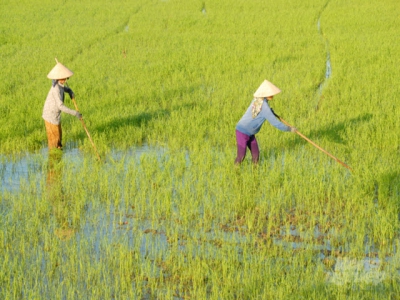Concerns about the soaring costs of autumn-winter rice production

The cost and price of producing the autumn-winter crop of 2021 will skyrocket, even more so now that the price of fertilizer has been galloping in recent years.
Due to the fact that the crop is often grown in unpredictable rain and storm conditions, there is a significant danger of weather-related problems and pests. Photo: Le Hoang Vu.
In the autumn-winter crop of 2021, River Delta farmers will confront a price rise in agricultural materials, particularly fertilizer, which has climbed by 50-80% year on year. To mitigate the impact of rising rice production costs on profits, farmers used a number of technical measures to improve the efficacy of fertilizer usage.
Nguyen Van Thich, Deputy Director of Tan Long Agricultural Cooperative in Hau Giang province, encouraged members to use methods such as reduced seed sowing, sparse planting, or rice ploughing machines to minimize production costs, fertilizer and pesticide usage. Increase fertilizer efficiency by applying fertilizer in a balanced and cost-effective way.
As the cooperative grows rice organically, it imported 150 tons of organic fertilizers from abroad in advance of the price increase.
Director Bach Van Son of Hau Giang's Subdepartment of Crop Production and Plant Protection said that despite high fertilizer costs in the past, farmers continued to invest in rice, and the quantity of fertilizer used dropped insignificantly, most likely without hurting output.
However, farmers substantially decrease the quantity of fertilizer used to fruit trees, with some families fertilizing just around 30% of the required amount, impacting the tree's development and therefore the production and output of the next crop.
For veggies, individuals are reluctant to plant seeds owing to difficult consumption, low pricing, and expensive fertilizer costs. To reduce production costs and ensure the safety and sustainability of products, the Sub-Department has directed a number of measures, including mobilizing farmers to implement advanced technical solutions such as "3 reduce 3 increase" and "1 must 5 decreases"; increasing the use of microbial organic fertilizers that break down nitrogen and phosphorus, as well as increasing the use of traditional organic fertilizers.
According to the An Giang Department of Agriculture and Rural Development, the province sows seeds on 160,000 hectares for the autumn-winter rice harvest 2021. Due to the fact that the crop is often grown in unpredictable rain and storm conditions, there is a significant danger of weather-related problems and pests.
At the moment, the situation with the Covid-19 epidemic is still complex, which means that certain areas may have labor shortages, resulting in slower sowing progress than during the same time last year. Meanwhile, fertilizer and pesticide prices continue to rise, increasing production expenses in the autumn-winter crop and the potential of increased production costs.
According to the department's spokesperson, 11 variables directly influence manufacturing costs, with raw materials accounting for 81.4 percent and labor accounting for just 18.6 percent.
While raw materials play a significant role in determining production costs and prices, there are four variables that have a significant impact on production costs, including the following: Fertilizer expenses account for the largest percentage of expenditures, at 25.1%. Pesticides rank second with 18.45 percent, harvesting costs rank third with 9.42 percent, and seeds rank fourth with 8.74 percent.
According to Department of Finance statistics, the production cost of rice in An Giang for the summer-autumn harvest 2021 is VND 4,197 per kg, and via monitoring, the average price for the autumn-winter crop production from 2017 to now is VND 4,017 per kg of rice. However, fertilizer prices will have the greatest impact on production costs. As a result, if fertilizer costs continue to climb, the cost of producing one kilogram of rice will increase as well.
Thus, An Giang's agricultural sector provides technological solutions to advise farmers on how to properly utilize fertilizers and pesticides in the autumn-winter crop in order to maximize earnings at the season's conclusion.
To begin, farmers must aggressively decrease input expenses that directly affect production costs, such as fertilizer, insecticide, seed, and harvesting costs, using sophisticated technological methods.
An Giang advises that farmers expand their usage of organic fertilizers in order to alleviate domestic pressure on inorganic fertilizer demand. Promote the need of alternating wet-dry irrigation to assist control rice falls, make harvesting easier, and reduce harvesting and shipping expenses. Promote IPM in production, thus lowering pesticide costs and ensuring the quality of rice for local and international markets.
Có thể bạn quan tâm
Phần mềm

Phối trộn thức ăn chăn nuôi

Pha dung dịch thủy canh

Định mức cho tôm ăn

Phối trộn phân bón NPK

Xác định tỷ lệ tôm sống

Chuyển đổi đơn vị phân bón

Xác định công suất sục khí

Chuyển đổi đơn vị tôm

Tính diện tích nhà kính

Tính thể tích ao hồ



 Vietnam holds the largest market share of 8…
Vietnam holds the largest market share of 8…  Vision to 2030 and certain aims of poultry…
Vision to 2030 and certain aims of poultry…